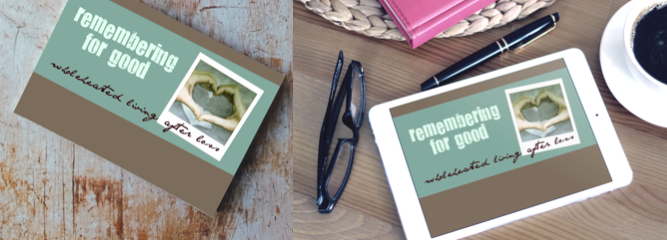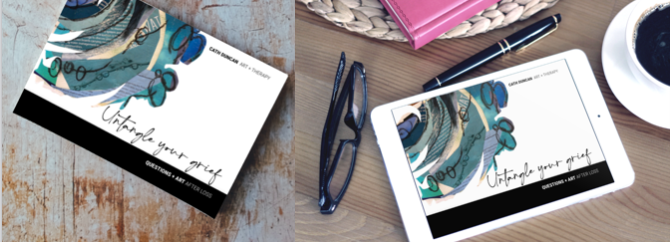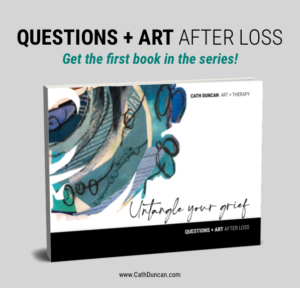There have been a lot of attempts to describe what grieving is and how it progresses. I’ve found it really useful to see grief as simply a process of learning. Sure, it’s probably the steepest learning curve you’ve ever been on, but grieving and learning to live wholeheartedly after loss is also a lot like the many other things that you’ve learned to do. And because I love learning (and I know that we all can learn), thinking of grieving as a process of learning helps me feel more resourceful and confident in my grief journey. I’ll explain more, and hopefully it can also help you to feel more resourceful and confident in your grief journey.
Learning at the deepest level, on the steepest learning curve…
In many ways, loss breaks our model of who we are, how life works and what we expected. It breaks all illusions of certainty, power and immortality and it challenges our trust and faith in ourselves and any greater power that we might believe in. We find ourselves feeling lost and groundless and questioning everything we thought we knew. We’re living in pretty much the same world we were before our loss, but suddenly we’re viewing ourselves and the world around us through a totally different lens – the lens of “my baby died” or “my husband died” or “my relationship died” or “my dream of having a child naturally died.” And everything that’s the same looks and feels different and it’s as if we have to learn it all over again.
Learning about yourself, learning about your model of the world, learning about your emotions and their triggers, learning what you want to be and create now that you understand how impermanent and precious life is, learning to manage emotional triggers, learning to live after loss… It’s a lot to learn, and it’s made even trickier by the fact that, as much as we might like there to be, there’s no universal curriculum for grieving and most of the journey to wholehearted living is a process of inventing rather than the sort of rote learning that most of us were taught throughout our schooling.
Also, we don’t get to stop the rest of our lives while we take a course and learn how to live after loss and then get back to life again. We have to learn on the job!
Learning (and grieving) at it’s essence…
While it’s a steep learning curve, grieving and learning to live wholeheartedly after loss doesn’t have to be complicated. It’s mostly about defining what wholehearted living means to you and then relaxing and practicing it. At first, just like any new thing you’re learning, it’ll be awkward, wobbly and maybe even a bit scary, and your results will be inconsistent. But over time, with relaxed deliberate practice, you’ll find it easy, just like you did when you learned to walk, talk or drive.
A lot of research has been done into the neuroscience of how we learn and what makes it easier or harder. It’s worth considering this research so that you can shape and optimize your learning experience. Gleaned from my interview with Dan Coyle, researcher of the neuroscience of learning and author of The Talent Code, here are some general tips on optimizing your learning that apply to learning to live wholeheartedly and a whole host of other things you might wish to learn when you’re living wholeheartedly:
1. Relax
Many of us have been taught that learning (and grieving) needs to be a stressful process. School was pressurized and we don’t remember anymore what it was like to learn easily, effortlessly and enjoyably like we did when we were babies. When we’re stressed, our brain literally changes the amount of information it can take in and the way that it processes information – we can take in much less information, we focus on negative information or sources of potential threat and risk, and we struggle with complex decisions, “big picture” perspectives and grey areas. Obviously this means that we don’t learn as easily or fast – especially considering that most of the stuff we’re needing to learn when to comes to living wholeheartedly after loss is how to see beyond risk, threat and loss, how to make difficult decisions, how to construct a new big picture for our lives and what the grey areas mean for us.
We all learn best when we’re relaxed. Shame is usually the trigger for getting stressed when we’re learning, so a big part of learning (and grieving) more easily and smoothly involves identifying and dissolving shame.
2. Know your preferred learning style
Think about the times in your life when you’ve learned most easily and quickly… what was your learning environment like? How did you approach the learning journey? What’s your natural learning style… do you prefer to read everything you can on the subject before you dive in and try stuff out? Or do you like to ditch the manual and try stuff out in order to experience things for yourself? Do you like to physically see what you’re learning, build models and take things apart to see how they work? Do you like to make visuals and keep notes in lots of different colors? Do you like to do lots of slow, gentle, layered preparation or do you like to leave your learning till the last minute and take a ‘crash course”?
Kolbe has a really useful model for identifying your learning styles. Here’s an article about the Kolbe tool in action. I’m a Fact Finder/ Implementer. I love to learn by reading up as much as I can and by doing/ taking things apart/ building metaphorical models and visual aids. After Juggernaut died, my Implementer lead my learning/ grieving journey for the first 6 months or so when I was too tired to read, and after that my Fact Finder came on board and I’ve been doing loads of reading about grief theory, resilience theory, learning theory and more. When you set your learning up to match your unique learning style, you’ll find it much easier to learn and you’ll enjoy the process more.
3. Learn in a compassionate community
Learning is a big part of evolutionary success and survival and we’re biologically wired to live and learn in community. That’s where we do it best and enjoy it most. When we’re learning in a compassionate community we feel seen and valued, we share wisdom and solutions, we give and receive feedback that enriches our learning, and the intimacy we feel adds meaning and ignites our motivation. Coyle identifies positive relationships and a sense of belonging as being key sources of ignition for the motivation to learn.
4. Focus and chunk it down to teeny steps
We learn best when we break skills down into small steps and focus on each small step one at a time, gradually building out a more complex skill. Don’t try to take in everything or change everything all at once. Focus on one to three small changes at a time, and make your changes in small steps.
5. Notice and appreciate the small gains
What we focus on when we’re learning determines what neural connections are strengthened and become faster until they’re the automatic default mode. When we’re stressed we tend to have a negativity bias, which means that we focus on what’s broken or not working yet, rather than what’s working well. We learn faster and we enjoy the learning process much more when we deliberately take time to focus on and celebrate the small gains along the way. This keeps us motivated through the hard “dip” of the learning process and strengthens the things we’re learning. From the perspective of living after loss, noticing the little “baby joys” that are starting to birth themselves opens the door to let peace, joy, creativity, love and faith in to sit alongside your grief and this is deeply comforting.
6. Holding open questions, rather than pursuing quick closure/ answers
As humans we hate uncertainty and unfamiliarity, because from an evolutionary perspective, it could be dangerous. So we tend to avoid it like the plague and do our best to dissolve it and get closure on the scary mysteries of life with “quick fixes” and easy or templated answers. This is a big red button that loss and grief pushes for all of us – and probably the reason why the notion of “closure” became so popular.
The problem with closure is that it shuts off access to creativity. When we have an open question, this creates creative tension and our minds search for potential answers. Our minds will only rest once we have the closure of an answer or decision. Creative tension feels like anxiety, fear and groundlessness, so we get really uncomfortable with it and try to end the creative tension by grabbing a quick answer or decision. But if we can hold the creative tension and carry our questions a little longer, we’ll often produce higher quality answers and solutions. And in many cases, we’ll also develop a greater comfort with uncertainty, unfamiliarity, diversity, impermanence and the many tricky mysteries of living, loving and losing.
So I’ll encourage you as you’re learning to live wholeheartedly to have the courage to allow for, and perhaps even to preserve, some uncertainty. Accept the mystery. Ask and carry your big questions about the meaning of life, about the existence of a greater power, about your personal narrative, about who you’ll become now that you’ve lost what you’ve lost – without being attached to getting an answer. You don’t have to have all the answers. There doesn’t even have to always be an answer. It’s safe to allow yourself to feel and then let go of the many unanswerable questions that loss will present you with.
7. Making errors means you’re learning
Most of us have been brought up with the idea that getting everything right means we’re learning. Actually getting everything right means we “have learned.” Making lots of errors means you “are learning.”
The new research into how we learn shows that the people who learn most quickly understand that the quickest way to learn looks something like this: try, fail, try again, fail again, try again, make a smaller mistake, try again, make an even smaller mistake, try again, get it right.
Because there isn’t a universal “right” way to grieve and live wholeheartedly after loss, you can’t really get it “wrong.” But you have your own “right” – your own truth about what wholehearted living after loss means to you, and what you need in your grieving journey. And as you go, you’ll test something out and realize that it’s wrong for you. Or you’ll know that something is wrong for you but you’ll go ahead and do it because shame overtook you and convinced you that you needed to please someone else. So there will be those sorts of errors. No problem – that’s all an indication that you’re learning. Just keep going and try again.
8. Rest, sleep, a healthy diet and exercise
Across the board, research has found that the most talented and skilled individuals practice hard, but they also rest often and well and sleep more than the average person. Learning (and grieving) is hard work and it’s been found that sleeping helps the brain to “digest” new learnings more easily. We can’t learn (or grieve) all of the time – our minds and bodies are designed for “pulsing.” We learn most efficiently when we have focused periods of learning followed by a total change of mode by either exercising our bodies or resting deeply. Your mind and body are not separate structures and you’ll learn (and grieve and heal) best when you’re looking after your body and keeping it in optimal health with good rest, regular sleep, a healthy diet and regular exercise.
So what do you need in order to grieve and learn more easily? What changes and commitments will you make to support yourself in your grieving and learning?
Would you like guidance to explore and heal your grief?
I’ve put together a 35-page grief “workbook” for you; an introduction to Remembering For Good and living wholeheartedly after loss. Learn more about the Remembering For Good grief workbook.
The first book in the QUESTIONS + ART AFTER LOSS series, Untangle Your Grief is a beautiful 65-page book of artful questions and creativity-sparking art prompts to help you to create meaning, belonging, and hope after loss.



